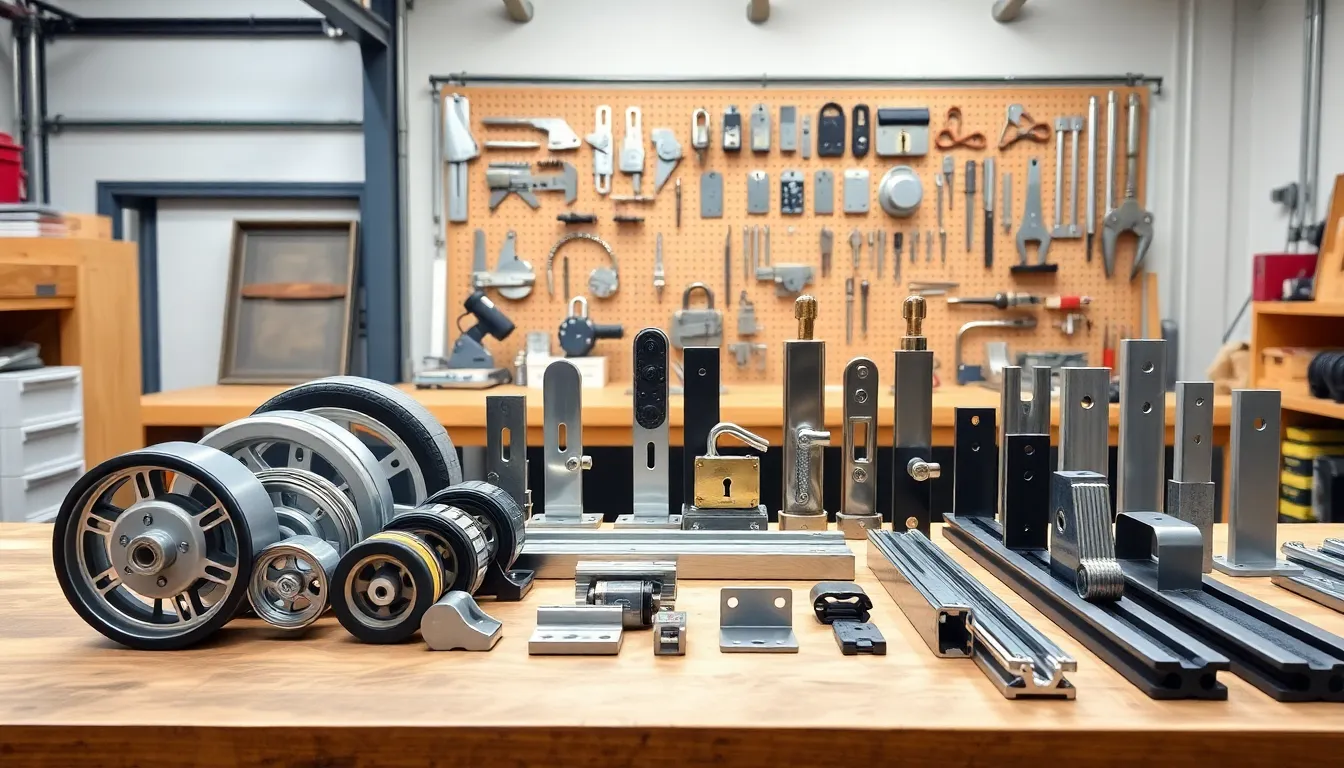Installing a rolling gate can be an exciting venture, offering both security and convenience. But before diving in headfirst, one must navigate the intricate world of rolling gate hardware. Trust me, there’s more to it than just slapping a couple of wheels on a frame and calling it a day. From components that may seem trivial to installation tips that could save a hefty repair bill later, this guide will walk you through everything you need to know to ensure your investment rolls smoothly. So, buckle up. We’re about to explore the ins and outs of rolling gate hardware.
Table of Contents
ToggleTypes of Rolling Gate Hardware

When it comes to rolling gates, you might be surprised at the variety of hardware available. Understanding these types can make a huge difference in your overall project. Here’s a quick breakdown:
1. Roller Wheels
These are the unsung heroes of any rolling gate. Roller wheels come in various designs, such as v-groove and flat wheels, serving different surface types. Be sure to choose the type that matches your gate’s design and surface for a smooth operation.
2. Tracks
The track guides the gate and supports its weight. Tracks vary in material and height. Stainless steel tracks are generally recommended for their durability and resistance to weather extremes.
3. Gate Stops
These are crucial to ensure that your gate doesn’t roll too far and get damaged. Installing a stop at both ends of the track can prevent accidents and prolong the life of the gate.
4. Brackets
These support various components and connect the gate to the tracks. The right brackets can make a world of difference in stability and safety, so choose high-quality options suitable for your specific gate.
5. Locking Mechanisms
A rolling gate isn’t just about aesthetics: security is a major factor as well. Invest in sturdy locking mechanisms, deadbolts or slide locks, that can withstand tampering. This ensures peace of mind whether at home or your business.
Essential Components of Rolling Gates
To ensure your rolling gate functions smoothly and securely, you need to be familiar with its essential components. Think of it like a puzzle: each piece plays a role in the bigger picture. Here are the key elements:
1. Gate Frame
The framework forms the backbone of the rolling gate. It can be constructed from wood, aluminum, or steel, each material offers different benefits. Steel frames, for instance, provide strength, while aluminum frames are lighter and rust-resistant.
2. Hinges
Ah, the often-overlooked hinges. They allow your gate to swing open and shut. When selecting hinges, make sure they are robust and compatible with your gate’s weight. A sturdy hinge will help prevent sagging over time.
3. Weather Stripping
A crucial yet simple element, weather stripping keeps out rain, dirt, and pests. It can drastically improve the durability of your gate while also providing a more comfortable environment indoors.
4. Automation System
In this day and age, who wants to get out of the car to open a gate? An automated system offers convenience and accessibility. Certain systems integrate with remote controls and smart home technology, allowing you to manage access from anywhere.
Installation Considerations for Rolling Gate Hardware
Installing rolling gate hardware isn’t merely a DIY task: it requires careful planning. Here are some installation considerations you should keep in mind:
1. Site Assessment
Before installation, assess the site thoroughly. Check for uneven surfaces, obstacles, or anything that could interfere with gate operation. A smooth installation today saves headaches tomorrow.
2. Precision Measurement
Every little measurement counts. A few millimeters can make a difference in how smoothly your gate rolls. Measure the width and height of the opening to ensure proper fitment of tracks and hardware.
3. Power Supply
If you’re opting for an automated system, plan for a power source. Is there a place for wiring? Ensuring a proper power supply is crucial for a functioning automated gate, minimizing future electrical problems.
4. Professional Help
If this sounds overwhelming, you’re not alone. Hiring professionals may save time and guarantee that your installation meets safety codes, eventually providing more peace of mind.
Maintenance Tips for Rolling Gate Hardware
Once you’ve successfully installed your rolling gate, maintenance is vital to ensure its longevity. Here are some handy upkeep tips:
1. Regular Inspections
Periodic checks go a long way. Examine all components for wear and tear, focusing on wheels, tracks, and hinges. Replace or repair any damaged parts immediately.
2. Lubrication
Boost performance and reduce wear with regular lubrication. Use a silicone-based product or garage door lubricant on wheels and tracks. Just don’t overdo it: slick is good, but greased is hazardous.
3. Clean the Tracks
Dirt and debris can build up over time, disrupting gate functionality. A quick clean will keep your rolling gate flowing smoothly. Regular cleaning keeps the wheels rolling and extends the life of your gate.
4. Check the Locking Mechanism
Security is key. Periodically inspect and test the locking mechanism. If it’s showing signs of rust or difficulty locking, replace it to maintain security.
Common Problems and Solutions
Like any mechanical system, rolling gates can face issues over time. Knowing these common problems and solutions can save you time and money.
1. Gate Won’t Roll Smoothly
Examine the tracks for obstructions or dirt buildup. Cleaning often resolves this issue. If the wheels are damaged, replacement is necessary.
2. Gate Off Track
This can happen due to wear or an obstruction. Carefully place the gate back on the track, and double-check hardware alignment, safety first.
3. Locking Issues
If a lock won’t budge, it may simply need lubrication. If that fails, it could need replacement entirely. Don’t risk security, better safe than sorry.
4. Sagging Gate
This typically indicates worn hinges. Replacing the hinges can solve this problem, giving your gate a new lease on life.
Choosing the Right Hardware for Your Rolling Gate
Picking the perfect hardware is essential for both functionality and aesthetics. Consider these factors to help in your decision:
1. Weight Capacity
Ensure your hardware can handle the weight of your gate. Check manufacturer specifications to find compliant components that ensure safety and longevity.
2. Material Quality
Opt for high-quality materials like galvanized steel or durable aluminum. Cheaper materials may save money in the short term but can lead to long-term problems.
3. Weather Resistance
Choose components designed for your specific climate to avoid corrosion or premature damage. Rain or snow can significantly affect hardware performance.
4. Aesthetic Appeal
Your hardware should complement your gate’s overall appearance. Consider finishes and colors that align with your property’s look creating a cohesive aesthetic.






